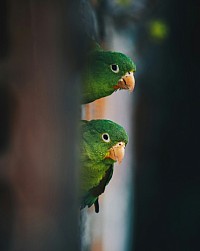Bridlington Parrot Sanctuary
Stop Hand Rearing Parrots
Published 19 September 2017
Why Hand-Rearing Parrots Should Be Stopped
Without any current regulations to control parrot breeding, the Parrot Crisis will continue to get worse. Breeders often remove chicks from their parents at around two weeks old to hand-raise them, to produce what they call "silly tame birds." The friendlier the bird, the higher its market value.
Unfortunately, some breeders prioritize profit over the long-term welfare of their birds.
Hand-reared parrots lose their natural behaviors and social skills typical of their species. Instead, they become imprinted on humans, perceiving us as their mates—what an unnatural and distressing situation.
These birds often crave human company exclusively, ignoring other birds, becoming jealous of family members, and displaying aggressive behavior due to missing out on essential social learning from their parents—skills necessary for normal bird behavior.
Also, check out: Why I Stopped Breeding Parrots by Debbie Thrift.
In more severe cases, these parrots become so dependent on people that they demand constant attention, frequently screaming loudly whenever their owner leaves the room. This behavior is a major reason many parrots are rehomed, as owners struggle to meet their birds' relentless need for attention and interaction.
Sadly, this often leads to neglect or mistreatment, resulting in damaged birds that are increasingly difficult to rehome.
Consequently, these parrots are passed from one home to another, sold and resold throughout their long lives.
Hand-rearing parrots should be banned. What do you think?
It’s important to note that hand-rearing parrots is already prohibited in places like the Netherlands and Australia.
For more information, visit: blogs.thatpetplace.com
Don't Breed Parrots, get involved with rescue work instead
As a bird rescue group, we are acutely aware of the severe overpopulation problem among parrots, which can live up to 80 years. So we strongly urge anyone considering breeding parrots or parakeets to reconsider and focus on rescue efforts instead.
If you want to get more involved with birds, we highly recommend partnering with a rescue group or starting a bird sanctuary for parrots or wild birds. If you need assistance with this, please contact us.
If you get involved in rescue work, it will allow you to meet a variety of different birds, each with unique behaviors and stories, making it a truly rewarding experience.
By choosing rescue, you will help improve the lives of birds rather than contributing to the crisis. While chicks are undeniably adorable, gaining the trust of a lost or abandoned bird offers an amazing and fulfilling experience.
Use this website to find a rescue group near you that may need volunteers: www.helpwildlife.co.uk
It is also crucial to consider the significant time and financial commitments involved in breeding parrots. Before breeding, you must ensure the parent birds are in a healthy condition.
Gender testing costs approximately £25 per bird. Additionally, fitness-to-breed checks by an avian veterinarian—required before and after each clutch to detect health issues and genetic diseases—can quickly accumulate, sometimes exceeding the bird’s value.
Egg binding in females can be fatal. Breeding birds must be maintained in excellent condition, fed a high-protein diet including egg food, and must always have calcium available in a separate dish to support healthy eggshell production.
Breeders should also be prepared to hand-feed chicks, because captive-raised parents may lack the social skills to properly raise their young. This can result in harmful behaviors such as injuring or neglecting chicks.
Hand-rearing requires investing in a humidity- and temperature-controlled brooder box and feeding chicks every 15–30 minutes when very young, then every 2–4 hours for older chicks, at least five times a day.
This is a very demanding, time-consuming task with risks like chicks suffocating. Even experienced individuals find hand-feeding challenging; it’s best left to the birds themselves and expert rehabilitators. Parents and chicks require close monitoring with minimal disturbance during this period.
Finally, breeders must be able to find loving, responsible homes for all the babies—a task often the most difficult. There are far more birds needing homes than there are suitable homes available.
It’s also emotionally challenging to give up a chick you raised to someone you don’t know and fully trust, and finding trustworthy adopters is even harder.
We urge you to consider the many faces on rescue websites—parrots that have been abandoned, abused, or neglected. Every new chick bred and sold indirectly displaces a bird that has been waiting months or years for a forever home.
As mentioned, sanctuaries are already overwhelmed with birds, and there simply aren’t enough responsible homes for them all.
Breeding parrots, parakeets, cockatiels, budgerigars, and lovebirds right now is neither humane nor responsible.
So please consider fostering a homeless parrot instead.

